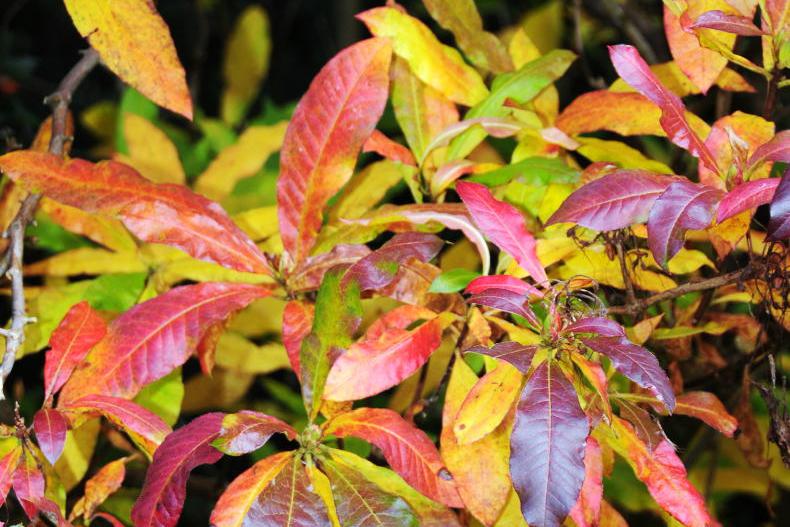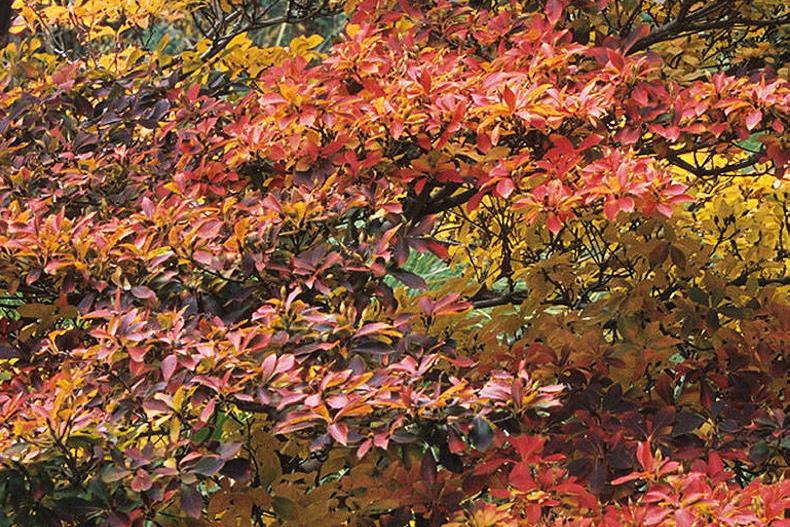Common name: Deciduous azalea
Botanical name: Rhododendron mollis
Botanical family: Ericaceae – the heather family
All azaleas are correctly rhododendrons but the name azalea was once the correct botanical name for these deciduous rhododendrons and is still current in usage.
Type
These azaleas are medium- to large-sized shrubs that are capable of growing to more than 2m wide and tall.
Decorative features
Deciduous azaleas offer a spectacular show of large clusters of funnel-shaped flowers, flared at the mouth. They range in colour from white, yellow, orange and red to various shades in between, such as apricot, peach, flame and salmon.
While largely taken for granted, these azaleas also put on a dramatic display of fiery autumn colour as the deciduous leaves fall. The colours exhibited include yellow, orange, red and rich wine purple. The ones that flower in yellow and light colours show yellow leaves in autumn, while the red-flowered varieties show the richer tones of orange, red and purple.
Use
Like any shrub, deciduous azalea can be used in a variety of ways, namely in a border of shrubs and perennial flowers. Alternatively, they look very striking, particularly in a country garden, in large drifts of varieties of varied or single colour.
Site requirements
While these azaleas are not very far from the original wild species and are quite tough, they are best given a site with some shelter and, ideally, sloping ground to show off the flower-covered tops of the plant in spring.
Soil requirements
Almost all rhododendrons, azaleas included, need to have neutral or acidic soil, well-drained and reasonably deep topsoil. Having said that, these azaleas can cope quite well at around pH7, or neutral pH, when given an annual light top dressing of leaf mould which slowly acidifies the azalea root zone.
Various studies have shown that wild bird populations can be supported to some degree by providing them with places to nest. In some cases, it is not a question of providing new nest sites but of preserving favourable existing locations. Such places can include dense shrubbery, sheds, other old buildings and nest boxes. These locations favour birds such as thrushes, blackbirds, wagtails, starlings, swallows, sparrows, dunnocks, house martins, pigeons and even owls. For some species, nest boxes help to make up for loss of suitable nesting sites in the local environment.

Nesting boxes.
The best-known type of nest box is the one suitable for blue tits and great tits, which has a round entry hole near the top of the nesting chamber. Nest boxes of this type are easily made from bits of timber and the dimensions are widely available online. This coming festive season, wooden boxes that are supplied with two bottles of wine are readily converted to nest boxes.
They can also be used with an open front to entice robins and wagtails to nest, although robins are very territorial and usually not more than a single pair occupies a good-sized garden.
It is best to put up nest boxes well before the breeding season starts in the new year because resident birds can get used to the presence of new objects. Nest boxes can be put up on trees, walls or buildings facing east or north but not south, because south-facing boxes can overheat on a sunny day and west-facing can be wet. There is no need to put nesting material in the boxes, it is best left to the birds themselves to gather.
Trees, shrubs and roses
Roses still have a few flowers in many gardens but can be tidied up in cold districts – shortened to prevent wind-rocking and fully pruned in mild areas. Most kinds of trees and shrubs do not like to be planted into ground that is wet in winter. Dig a few test holes to at least 30cm to see if they hold water. Then choose appropriate species.
Fruit, vegetables and herbs
Fruit trees and bushes can be planted if the soil is not too wet, as the roots can suffer damage from lack of oxygen in the soil. Fruit tree pruning can be carried out, except on plums. Control weeds and grass around fruit trees and bushes. Prune and tie-in trained fruit trees. Italian parsley, chives and wild rocket are still available.
Lawns
Lawns can be very soft and should not be walked on if there is a squelching or bubbling sound. It can be very damaging to the soil structure to walk over its surface when it is wet, but there will be occasional spells of dry weather when the ground will firm up enough to carry out a one-off mowing, even in midwinter.
Flowers
Plant spring bulbs that were purchased but not planted. Already they are beginning to shrivel. Plant new perennials if the ground is not too wet. If the ground is wet, do not undertake division and replanting. Many flowers do not like being moved into cold, wet ground. Ornamental grasses should not be divided until spring.
Greenhouse and house plants
Check for pests on greenhouse, conservatory and house plants, especially scale insects. Water just enough to keep plants moist but slightly on the dry side. Tidy the greenhouse and check that snails have not settled in for the winter as they can do severe damage during mild weather.
Read more
In the garden with Gerry Daly: ravishing redvein
Gerry Daly: monster trees
Common name: Deciduous azalea
Botanical name: Rhododendron mollis
Botanical family: Ericaceae – the heather family
All azaleas are correctly rhododendrons but the name azalea was once the correct botanical name for these deciduous rhododendrons and is still current in usage.
Type
These azaleas are medium- to large-sized shrubs that are capable of growing to more than 2m wide and tall.
Decorative features
Deciduous azaleas offer a spectacular show of large clusters of funnel-shaped flowers, flared at the mouth. They range in colour from white, yellow, orange and red to various shades in between, such as apricot, peach, flame and salmon.
While largely taken for granted, these azaleas also put on a dramatic display of fiery autumn colour as the deciduous leaves fall. The colours exhibited include yellow, orange, red and rich wine purple. The ones that flower in yellow and light colours show yellow leaves in autumn, while the red-flowered varieties show the richer tones of orange, red and purple.
Use
Like any shrub, deciduous azalea can be used in a variety of ways, namely in a border of shrubs and perennial flowers. Alternatively, they look very striking, particularly in a country garden, in large drifts of varieties of varied or single colour.
Site requirements
While these azaleas are not very far from the original wild species and are quite tough, they are best given a site with some shelter and, ideally, sloping ground to show off the flower-covered tops of the plant in spring.
Soil requirements
Almost all rhododendrons, azaleas included, need to have neutral or acidic soil, well-drained and reasonably deep topsoil. Having said that, these azaleas can cope quite well at around pH7, or neutral pH, when given an annual light top dressing of leaf mould which slowly acidifies the azalea root zone.
Various studies have shown that wild bird populations can be supported to some degree by providing them with places to nest. In some cases, it is not a question of providing new nest sites but of preserving favourable existing locations. Such places can include dense shrubbery, sheds, other old buildings and nest boxes. These locations favour birds such as thrushes, blackbirds, wagtails, starlings, swallows, sparrows, dunnocks, house martins, pigeons and even owls. For some species, nest boxes help to make up for loss of suitable nesting sites in the local environment.

Nesting boxes.
The best-known type of nest box is the one suitable for blue tits and great tits, which has a round entry hole near the top of the nesting chamber. Nest boxes of this type are easily made from bits of timber and the dimensions are widely available online. This coming festive season, wooden boxes that are supplied with two bottles of wine are readily converted to nest boxes.
They can also be used with an open front to entice robins and wagtails to nest, although robins are very territorial and usually not more than a single pair occupies a good-sized garden.
It is best to put up nest boxes well before the breeding season starts in the new year because resident birds can get used to the presence of new objects. Nest boxes can be put up on trees, walls or buildings facing east or north but not south, because south-facing boxes can overheat on a sunny day and west-facing can be wet. There is no need to put nesting material in the boxes, it is best left to the birds themselves to gather.
Trees, shrubs and roses
Roses still have a few flowers in many gardens but can be tidied up in cold districts – shortened to prevent wind-rocking and fully pruned in mild areas. Most kinds of trees and shrubs do not like to be planted into ground that is wet in winter. Dig a few test holes to at least 30cm to see if they hold water. Then choose appropriate species.
Fruit, vegetables and herbs
Fruit trees and bushes can be planted if the soil is not too wet, as the roots can suffer damage from lack of oxygen in the soil. Fruit tree pruning can be carried out, except on plums. Control weeds and grass around fruit trees and bushes. Prune and tie-in trained fruit trees. Italian parsley, chives and wild rocket are still available.
Lawns
Lawns can be very soft and should not be walked on if there is a squelching or bubbling sound. It can be very damaging to the soil structure to walk over its surface when it is wet, but there will be occasional spells of dry weather when the ground will firm up enough to carry out a one-off mowing, even in midwinter.
Flowers
Plant spring bulbs that were purchased but not planted. Already they are beginning to shrivel. Plant new perennials if the ground is not too wet. If the ground is wet, do not undertake division and replanting. Many flowers do not like being moved into cold, wet ground. Ornamental grasses should not be divided until spring.
Greenhouse and house plants
Check for pests on greenhouse, conservatory and house plants, especially scale insects. Water just enough to keep plants moist but slightly on the dry side. Tidy the greenhouse and check that snails have not settled in for the winter as they can do severe damage during mild weather.
Read more
In the garden with Gerry Daly: ravishing redvein
Gerry Daly: monster trees












SHARING OPTIONS